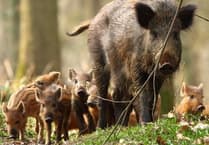A pair of Eurasian Beavers have returned to the Forest of Dean for the first time in around 400 years.
It is expected that the beaver’s activity in the Forest of Dean will improve biodiversity in their new 6.5 hectare home and may have the potential to reduce local flood risk. Regular monitoring will continue on site throughout the three-year project to assess these ecosystem benefits.
The release, which took place on Tuesday, July 24th, was attended by Environment Secretary, Michael Gove, who announced £20,000 of new funding for the Devon trial reintroduction of beavers to understand further the impact of bringing back one of England’s native species.
Environment Secretary, Michael Gove said: “The beaver has a special place in English heritage and the Forest of Dean. This release is a fantastic opportunity to develop our understanding of the potential impacts of reintroductions and help this iconic species, 400 years after it was driven to extinction. The community of Lydbrook has shown tremendous support for this scheme and the beavers will be a welcome addition to local wildlife.
“The project is an example of our wider approach to enhancing biodiversity. It is another step towards our aim of leaving the environment in a better state for future generations.”
Forestry Commission Forest Management Director, West England Forest District, Kevin Stannard said: “The release of Beavers is a momentous occasion for the Forest of Dean. We are looking forward to seeing the ecological and hydrological benefits the beavers will bring to the Greathough Brook.”
The Forestry Commission unveiled plans for a trial reintroduction into the Greathough Brook in March 2017. Since then, Natural England granted Forestry Commission officials a licence to release beavers into a carefully chosen and secure site which is now being used to house the semi-aquatic mammals.
Hydrological and ecological monitoring on the site is producing valuable scientific data and work is underway to ensure this informs future reintroductions.
Records show that the Greathough Brook was once home to thriving populations of water vole, glow-worms as well as wood white and pearl-bordered fritillary butterflies. These species depend on light, warm conditions – conditions that can no longer be found with the decline in sheep grazing and shading from trees.
Beavers are well known for their ability to fell trees to dam shallow watercourses and create pools to make them feel safe. The associated wetlands, interconnecting beaver canals, coppiced woodland, glades and deadwood provides rich and diverse habitat for an abundance of wildlife including plants, insects, amphibians, reptiles, birds and mammals.
Lydbrook has been subjected to several flooding events due to high volumes of water quickly running down the Greathough Brook and into the culvert system. This trial will identify how the beaver’s dam building behaviour can help to hold larger volumes of water higher upstream in the natural pools and wetlands that will be created within the valley. The dams are permeable, allowing water to be gradually released downstream and slow the flow of water.
Funding for the Forest of Dean project was secured in part by grants from The Gloucestershire Environmental Trust and Forest Holidays.





Comments
This article has no comments yet. Be the first to leave a comment.